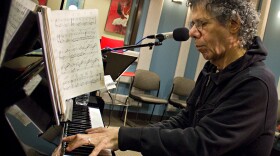Listen to the story above or read the script below:
A descendent of earlier piano styles like ragtime and stride, boogie-woogie was born in the late 1870s.
Like ragtime and stride, the defining feature of boogie-woogie is the repeating bass pattern in the left hand; a strong eight-to-the-bar feel, either fast or slow, is what propels boogie-woogie.
The name “boogie-woogie” has roots in several African languages, including Hausa, Bantu, and Mandingo—and all with similar meanings, like “to dance wildly,” or “to take flight.”
Marshall, Texas claims to be the birthplace of boogie-woogie. The Black loggers and railroad workers in that region spent their nights and weekends in the barrel
house bars, where there was usually a piano. After long days of cutting trees and loading logs onto locomotives headed for sawmills, the nights were spent consuming large amounts of alcohol and dancing to the boogie-woogie.
Boogie-woogie migrated north with the workers in the early 1900s, and by 1920, in the Black communities of St. Louis, Chicago, New York and Detroit, the term “boogie” was associated with an early version of crowdfunding, known as the “house rent party.”
If you couldn’t make your rent that month, you cooked up some food and opened your front door. Your neighbors would pay a small fee, and bring a bottle to share. Everyone would eat, drink and dance to the energetic piano music. If you threw a good party, you’d get enough money to pay your rent. The pianist would get a portion of the money collected, as long as they kept the music lively.
In 1929, “Pinetop’s Boogie Woogie” by Pinetop Smith was the first boogie-woogie hit record. The famous record label Blue Note’s first release in 1939 was boogie-woogie by accomplished jazz pianists Meade Lux Lewis and Albert Ammons. Along with Pete Johnson, they brought boogie-woogie to the integrated, sophisticated Café Society in New York City.
You needed strength and stamina to pound out boogie-woogie piano tunes all night, so for many years, only men claimed the boogie-woogie, until innovators like Mary Lou Williams, Cleo Brown and Hadda Brooks proved that women could boogie-woogie, too.
Eventually, boogie-woogie evolved from solo piano to piano duos and trios, and to guitar, and larger bands. Regional flavors were added; Chicago had its own style of boogie-woogie, and New Orleans pianists mixed the sounds of boogie-woogie, swing, Latin rhumba, and the beat of the second line.
Boogie-woogie was a building block for big band jazz, country swing, and early rock and roll.
KNKX Celebrates Jazz Appreciation Month
Throughout the month of April, we will be illustrating different styles of jazz through time that make up jazz history through storytelling and music. From the early 1900’s to 2022, we will journey from Dixieland to Modern Jazz styles, Big Band to Hip Hop.
Listen to installments each weekday at 9am and 7pm on 88.5 FM and KNKX.org. See all stories from the KNKX History of Jazz project.








